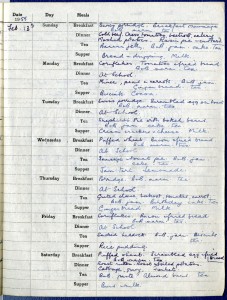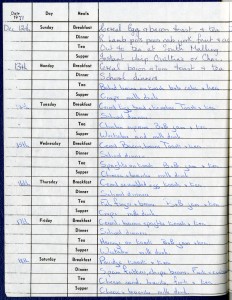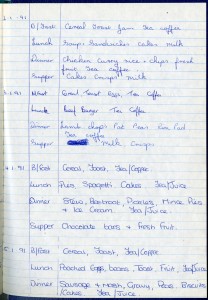It’s easy to forget that the past not only looked different to the present, it tasted different too. In today’s post we’ll take a look at some dietary diaries to see how people’s diets have changed over the past 60 years.
A lot of The Children’s Society’s children’s homes started keeping dietary diaries in the mid-20th Century. These diaries list the food that was fed to the children in the homes each day and so are a great resource for studying diet. (As long as you don’t study them on an empty stomach, that is, otherwise you may find yourself daydreaming about food rather than working, as I have found out to my own embarrassment!)
The first dietary diary I’m going to share with you today comes from St Agatha’s Home for Girls in Princes Risborough, Buckinghamshire, and dates from 1955.
1955 Feb. 13th
Sunday
Breakfast – Swiss porridge. Breakfast sausage B&B marm. tea.
Dinner – Cold beef. Cress tomatoes. beetroot. celery Mashed potatoes. Raisin pie – custard
Tea – Banana jelly. B&B. jam. cake. Tea.
Supper – Bread & dripping. Milk.
Monday
Breakfast – Cornflakes. Tomatoes & fried bread. B&B. marm. Tea.
Dinner – At School.
Tea – Mince, peas and carrots. B&B. jam. Gingerbread. tea.
Supper – Biscuits. Cocoa.
Tuesday
Breakfast – Swiss porridge. Scrambled egg on toast B&B. marm. tea.
Dinner – At School.
Tea – Shepherd’s Pie with baked beans. B&B. jam. cake. tea.
Supper – Cream crackers & cheese. Milk.
Wednesday
Breakfast – Puffed wheat. Bacon & fried bread. B&B. marm. tea.
Dinner – At School
Tea – Sausage & tomato pie. B&B. jam. cake. Tea.
Supper – Jam tart. Lemonade.
Thursday
Breakfast – Porridge. B&B. marm. tea.
Dinner – At School.
Tea – Grated cheese. beetroot. tomatoes. carrot. B&B. Jam. Birthday cake. Tea.
Supper – Gingerbread. Milk.
Friday
Breakfast – Cornflakes. Bacon & fried bread. B&B. marm. tea.
Dinner – At School.
Tea – Smoked haddock. B&B. jam. Biscuits tea.
Supper – Rice pudding.
Saturday
Breakfast – Puffed wheat. Scrambled egg & fried Bread B&B. marm. Tea.
Dinner – Roast mutton. Roast & boiled potatoes. Cabbage. gravy. Junket.
Tea – B&B. paste. Almond buns. Tea.
Supper – Buns & milk.
A lot of this food may seem rather conservative now: cooked breakfasts and fish on Fridays, all eaten with lots of bread and butter. However, this was a time when food rationing had just ended in the UK so you can imagine that many of the items here, like banana jelly, would have been quite exciting for the children eating them.
There doesn’t seem to be much processed food in this diet, with the notable exceptions being breakfast cereals, paste, baked beans and cream crackers. It’s also to interesting to note just how much tea the children were drinking, which is not necessarily a drink we associate with children these days.
And if anyone has eaten Swiss porridge or junket, I’d love it if you could tell me a bit more about them in the comments!
The next diary we have comes from the Harvey Goodwin Home in Cambridge and dates from 1971.
1971 Dec 12th
Sunday
Breakfast – Cereal Egg & bacon toast, & tea
Dinner – R. Lamb pots peas cab York, fruit & cus
Tea – Out to tea at South Malling
Supper – Instant whip Ovaltine or Choc.
13th
Monday
Breakfast – Cereal bacon & tom toast & tea
Dinner – School dinners
Tea – Baked beans on toast b&b cake & tea.
Supper – Crisps milk drink
14th
Tuesday
Breakfast – Cereal Egg bread & tomatoes. Toast & tea
Dinner – School dinners.
Tea – Chicken supreme. B&B jam & tea.
Supper – Weetabix and milk drink.
15th
Wednesday
Breakfast – Cereal. Bacon, beans Toast & tea.
Dinner – School dinners.
Tea – Spaghti on toast. B&B jam & tea.
Supper – Cheese & biscuits milk drink.
16th
Thursday
Breakfast – Cereal scrambled egg toast & tea.
Dinner – School dinners.
Tea – Fish finger & beans. B&B jam & tea
Supper – Crisps milk drink.
17th
Friday
Breakfast – Cereal. bacon spaghti toast & tea.
Dinner – School dinners.
Tea – Herrings on toast B&B jam & tea.
Supper – Weetabix milk drink.
18th
Saturday
Breakfast – Porridge toast & tea
Dinner – Spam fritters, chips. beans. Fruit & custard
Tea – Cheese sand. biscuits, fruit & tea.
Supper – Cheese & biscuits milk drink.
In this diet we begin to see the rise of processed foods: fish fingers, spaghetti on toast, crisps, instant whip and Ovaltine. Baked beans and breakfast cereals also seem to be eaten with more frequency than they were a decade and a half before.
And then there are some foods that seem to be very much of their time, such as chicken supreme and spam fritters! Do you remember those?
That said, there are similarities with the previous diet. A lot of bread and butter is being eaten and a lot of tea is being drunk; roast meals are a weekly occurrence; fish is eaten on a Friday; and there is always a cooked element to breakfast.
Our last diet dates from 1991 and comes from the Pimlico Road Home in Clitheroe, Lancashire.
2.1.91 [Wednesday]
B/Fast – Cereal Toast Jam Tea coffee.
Lunch – Soup & Sandwiches cakes. milk.
Dinner – Chicken Curry rice & chips fresh. Fruit Tea coffee.
Supper – Cakes Crisps Milk
3.1.91 [Thursday]
B/Fast – Cereal. Toast. Eggs, Tea Coffee
Lunch – Beef Burger Tea Coffee.
Dinner – Lamb chop’s Pot Pea’s Rice Pud. Tea coffee.
Supper – Milk. Crisps
4.1.91 [Friday]
B/Fast – Cereal, Toast, Tea/Coffee.
Lunch – Pies. Spagetti. Cakes. Tea/Juice.
Dinner – Stew, Beetroot, Pickles, Mince Pies & Ice Cream. Tea/Juice.
Supper – Chocolate bars & fresh fruit.
5.1.91 [Saturday]
B/Fast – Cereal, Toast, Tea/Coffee.
Lunch – Poached Eggs, beans, Toast, Fruit, Tea/Juice
Dinner – Sausage & Mash, Gravy, Peas. Biscuits/Cakes. Tea/Juice.
You might notice that by this time the standard printed dietary diary books have gone and that the staff have had to draw up their own book. This means that we can now see a difference in the names of the meals; ‘tea’ is gone and ‘lunch’ has suddenly appeared, pushing ‘dinner’ into the slot that ‘tea’ used to take. Of course, the names of meals can differ by place as well as by time, so there’s nothing to say that these names were in country-wide use in the 1990s.
As for this diet, we can see some less traditional food creeping in, such as curry and rice. Beef burgers are also present while a cooked breakfast in the morning and the ubiquitous bread and butter are almost completely lost. The availability of coffee in the morning is interesting, but this may be down to the age of the children in the home rather than the decade.
All in all, though, there is not too much to separate this diet from the diets of the 1970s and 1950s. Main meals are often made up of ‘meat and two veg’; tea is given to the children throughout the day; and supper is regularly made up of something sweet and a milky drink. It would be interesting to know what this sort of diary would say today. Do these diets represent how the population ate as a whole or were the meals cooked in residential homes slightly different to those eaten in other households?
A point we mustn’t forget is that diet can vary by region and by age as well as by the time-period, so it’s not possible to conclude that the differences between these three diets are based on the decade alone. It would be worthwhile, therefore, to take diaries from the same year for several different homes and see if there was much variation between them.
That’s a potential project for the future, though. Right now, I’ve managed to make myself hungry again! (Oh dear.)
If you’d like to share your experiences of any of these foods in the comments, then please do. Or perhaps you know some other foods that bring back memories of a certain era. Arctic Roll, anyone?




Junket is a sweetened milk based dessert which is set with rennet. It has been made for hundreds of years, but has become much less widely eaten in the last 40 years or so.
Thanks for this! I wonder what it tastes like; hopefully not too much like blancmange (which is one of those foods that I’ve never taken to). I shall ask around and see if anyone I know has eaten it.
Janine
The homes’ diet books that featured in Friday’s Unexplored Riches blog have led to numerous discussions about food we remember. The following links may jog a few memories – so jot down your food memories here!
In the 1960s SPAM® Chopped Pork & Ham – particularly in fritter form – becomes a regular feature of school menus. The Spam website has a good history section! http://www.spam-uk.com/history
Junket: this is similar to how my grandmother used to make Junket: http://uk.ask.com/question/how-do-you-make-junket
Swiss porridge: well, fewer people seem to know about this, but the consensus of opinion is that is porridge with fruit mixed in. A slightly more exotic recipe can be found here: http://www.sircookalot.com/en/swiss_porridge_recipe170203.html
Instant Whip v Angel Delight: this site has a full history! http://h2g2.com/approved_entry/A70365530
(h2g2 is a constantly expanding, user-generated guide to life, the universe and everything. The site was founded in 1999 by Hitchhiker’s Guide to the Galaxy author Douglas Adams.)
Thanks for the links, Ian. Very interesting. I’m not sure how I feel about Angel Delight, but I’ve always quite enjoyed SPAM (perhaps I shouldn’t admit to that!) We’ve been discussing swiss porridge this morning; it sounds healthy and tasty!
Instant Whip – for a time it was the thing to have with tinned fruit at teatime in the 1970s! I remember it being on offer in the (newly emerging) supermarkets and for some reason it was cheaper than ‘real’ cream (which also came in tins!) and somehow preferred. Tinned cream was also a treat, as was condensed milk; this last was so thick, you could spread it on bread and butter – and it was great! We must have eaten fresh cream, but I just don’t remember it that much. It must have been harder to get or more expensive then. How things have changed!
I remember my Mum buying frozen cream in the 1980s/90s. It came in little logs and, as a child, the sight of them defrosting in the kitchen was very exciting because it heralded cream with dessert later that day! Not really something you see nowadays, unless I’ve missed them hiding in the freezer aisle.
Ovaltine has a long history since 1915 and is still enjoyed today!
The following websites contain insights into the history of the drink:
Ovaltine factory history: http://www.kingslangley.org.uk/ovaltine.html
The BBC report on the factory’s closure in 2001 has a brief history too:
http://news.bbc.co.uk/1/hi/business/1258643.stm
Thanks for the extra links! I’ve never actually tried Ovaltine. I should give it a go sometime!
Enjoyed this! I always enjoy the resources you offer from the Children’s Society Archive. It is fascinating to see the care with which these records were kept – especially today when we are so concerned at the gaps in the services for looked-after children, children in care.
Thank you! We’re really glad you enjoy them.
SWISS PORRIDGE – could this be a version of the Swiss “Birchermuesli” which is a mixture of oats, fruit and nuts (just as we know muesli today) but it is poured into each dish and covered with milk (or often yoghurt) the night before so that the muesli is soft and easily digested rather than the crunchy experience that most British people know. This recipe was invented in the late 19th century by Maximilian Oskar Bircher-Benner, M.D., a Swiss physician and nutritionist.
When I worked in Switzerland (for one of their banks, I have to say sotto voce) Birchermuesli was often served in the works canteen as an optional main course for lunch.
Dear John,
Thank you very much for this information on Swiss porridge. It’s really interesting to know that it’s eaten for lunch in Switzerland.
Janine
In the care home I was in during the 1950’s “Scrunch” was always on the meal table being rusks of baked discarded or leftover or somewhat stale yet still perfectly edible thick bread slices that had been turned to a crust (not browned or burned) at the bottom of the care homes solid fuel (anthracite) ESSE oven, perhaps, while other baking was going on on the upper oven shelves. Children devoured Scrunch laden with a coating of butter and strawberry jam or other spread quite happily. “Scrunch” “Scrunch” Scrunch” Yummee!
Thanks for this, Bobbie.
Scrunch sounds really delicious! I wonder if it was served at any of The Children’s Society’s homes, perhaps under the title of ‘toast’ in the dietary diaries? Or perhaps it wasn’t very widespread? Does anyone else remember eating scrunch?
(Apologies for the lack of an editing tool for comments, but I have made the change to your comment that you suggested.)
Janine
I’m assuming that Swiss porridge is actually muesli. I have only had junket once – I was six years old and a passenger on a Dutch ship crossing the Atlantic to England. I remember the junket because I’d just been sick and this very fierce Dutch nurse sat me on her lap and forced me eat this slippery yellow junket. To be fair, I don’t think she knew that I’d just been sick but I REALLY did not want to eat that junket. It’s the only food I remember from that crossing.
Dear Rosie,
Thanks for sharing. That sounds like the sort of experience that could put you off junket for a long time!
Janine
I think the biggest change was the substitution of protein at breakfast with cereals (grains) which, interestingly, is now being challenged by the dietary experts who are saying that protein is better than processed grains which effectively are just sugar.
Thanks for pointing this out. The rise in cereals for breakfast is a very interesting trend. They went from not being eaten much at all to dominating the breakfast table.
Interestingly, when you look at some of our really early dietary records, like the 1888 dietary sheet from St Aldhelm’s Home in Frome that can be seen on this page, you see that protein wasn’t much of a feature of breakfast time then either. In this case, breakfast was dominated by bread and butter, and if you include the jam or treacle as well, then it sounds as if an 1888 breakfast was just as sugary as some of the sweet cereals you get today.
The other interesting thing is there are four set meals a day, with supper including food and not just a drink. I reckon eating times are now much more fluid, along with what is eaten – less meat and two veg and more influenced by food that takes less time to prepare, from pasta to fast food.
That’s a very good point. The time for the main evening meal seems to be moving later and later, so perhaps that’s why fewer people seem to eat supper nowadays.